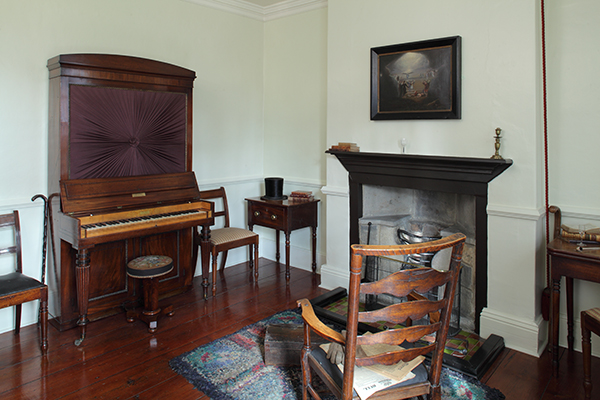Haworth, Yorkshire
By Tony Canavan
In the townland of Emdale, Co. Down, are the ruins of a little cottage that has a bronze plaque with the inscription: ‘Patrick Brontë, father of Charlotte, Branwell, Emily and Anne, was born here on 17th March 1777’. From such humble Irish beginnings sprang three of the most famous female authors in English literature—Charlotte, Emily and Anne Brontë. Their father was named Patrick not only for being born on St Patrick’s Day but also because his maternal grandfather was Patrick McClory, father of Eleanor Alice McClory, who married Hugh Brunty in Magherally parish church, Banbridge, Co. Down. For those who wish to explore more of the Brontë family’s origins, there is a self-guided ‘Brontë Homeland Drive’.

While the local council in County Down does its best to exploit the Irish connections of the Brontës, apart from the ruins of Patrick’s cottage there is nothing as substantial in terms of remains as the parsonage in Haworth, Yorkshire, the Brontë family home where the famous writers were raised and spent most of their adulthood. The Brontë Parsonage Museum acknowledges that the paterfamilias was Irish but does not dwell too long on their Irish background or the possible Irish influences on the Brontës’ novels. Nevertheless, it is a fascinating place to visit.
The museum has changed greatly since my first visit about 30 years ago. As well as recreating what the house would have been like when the Brontës lived there, the museum also houses memorabilia connected with them and the world’s largest collection of manuscripts, letters and early editions of their published works, such as Emily Brontë’s Wuthering Heights and Anne’s The tenant of Wildfell Hall. The new museum has achieved that rarity of keeping the substance and character of the original building while providing up-to-date displays and exhibition space. Staffed by enthusiastic volunteers, it would be quite easy to spend hours there, learning from them the many stories associated with the Brontës and the intimate details of their lives. That said, the museum is celebrating Patrick’s life and legacy this year with a new exhibition, ‘Patrick Brontë: In Sickness and in Health’, and a number of events and talks focusing on the remarkable father of the Brontës.

The visitor enters through the front door into the reception hall. The tour through the museum is self-guided, although there are volunteer attendants on hand to answer any questions. It is easy to navigate, as each room is numbered and named, with information panels inside. On one side of the hall is the dining room, where a table is laid out with memorabilia of the Brontës and the famous portrait of Charlotte hangs above the fireplace. It was here that the sisters wrote their novels, pacing up and down, reading aloud what they wrote for the others to comment on. Across from this is Patrick Brontë’s study, complete with desk, an armchair and a piano. The Revd Brontë spent most of his time here, as it is where he conducted parish business, wrote sermons and so on. On the ground floor, too, is a kitchen, fitted out as it would have been in the nineteenth century. It is a reminder that in telling the story of the Brontës the museum also provides an insight into the society of that time. Even a family as humble as they were employed servants.

Upstairs, you can follow the numbers of the rooms to get further insights into how the Brontës lived. Charlotte’s room is dominated by the beautiful silk dress that she wore when she married Irishman Arthur Bell Nicholls. Interestingly, much of the Brontë memorabilia survived in the house in which he originally lived in Banagher, Co. Offaly. In Charlotte’s room, as throughout the house, are examples of the Brontës’ paintings. They were not just literary geniuses but also accomplished painters (or at least the sisters were). Other rooms upstairs are the children’s study, Mr Brontë’s bedroom and Branwell’s studio.

Of all the Brontës, Branwell is perhaps the most enigmatic. Never as talented as his sisters, he lived in their shadow, although he loved them dearly. He tried to be creative too, first as a writer and then as a painter. He was not a great success at either and sought consolation in drink, which was what brought about his early death. His study is perhaps the most striking of all. The museum has done its best to recreate his tortured and chaotic mind in the cluttered and chaotic state of the room dedicated to him. His life was as short and tragic as his sisters’, but he is largely overlooked in the public imagination.
The tour ends with the new, modern exhibition area. This is situated in an extension to the original house, built by one of Patrick’s successors. It contains further examples of the Brontës’ art and writing, but it also places them in their historical and literary contexts. Here you can see early editions of their novels, the critical reaction to them and how the Brontë cult has grown in subsequent centuries. Beyond this are those ominous words, ‘Please exit through the gift shop’.
Tony Canavan is editor of Books Ireland.
